As an Amazon Associate, we earn from qualifying purchases with no additional costs for you.
Japanese knives are considered by many to be the epitome of quality kitchen knives, each with its own cutting specialty. Most people know that most Japanese knives are designed for certain kitchen tasks, meaning you need different knives for processing different ingredients. What Japanese knives would be best suited to cutting meat, bones, and fish?
The best Japanese knives for cutting meat and fish are the Gyuto, Santoku, Honesuki, Sujihiki, Yanagiba, and the Deba. The Honesuki and Hankotsu are both deboning knives used to cut meat from the bone but they cannot cut through bone. The Garasuki is used to cut through poultry bone.
Japanese knives are exceedingly sharp and hold an edge very well due to the steel they are made from. This makes certain Japanese knives ideal for processing proteins in the kitchen. However, there is not a one-size-fits-all solution for processing meat with Japanese knives. You still need to make the right knife selection for the job.
If you are interested in checking out the best Japanese knives (made by Hayate Yoshihiro) we recommend and use, you can find them by clicking here (Amazon link).

What Is The Best Japanese Knife For Cutting (Raw) Meat?
While Japanese knives have specialized tasks in the kitchen, several different types of knives can be used to process raw meat in the kitchen.
Are Gyuto Knives Good For Cutting Raw Meat?
The Japanese Gyuto (Amazon link) is the equivalent of the multipurpose Western chef’s knife. Even though the Gyuto has multipurpose use in the kitchen, it definitely has a meat-cutting bias in its design.
The relatively long blade allows the user to slice through a piece of meat with fewer draws of the knife through the meat. This makes for a cleaner, neater cut and preserves the juice in the meat.
The caveat for using a Gyuto to slice raw meat is that the meat must be boneless. Accidentally cutting into bone while slicing the meat will damage the edge on your Gyuto.
If you are interested in buying a high-quality Gyuto knife, we recommend checking out this knife made by the Yoshihiro company (Amazon link). The alternative (and cheaper) option is the Gyuto knife made by Tojiro (Amazon link).
Can You Cut Raw Meat With A Honesuki?
The Honesuki (Amazon link) can be used to cut raw meat. It is a smaller knife with a blade of between 5.3 inches and 7 inches.
This smaller blade size makes the knife perfect for processing poultry and other smaller animals, such as rabbits. The design of the tip of the Honesuki makes it ideal for penetrating the joints of poultry to separate the carcass into its component pieces.
The Honesuki is often referred to as a poultry boning knife since it is most commonly used to debone a chicken carcass.
The Honesuki can also be used to cut raw chicken meat, such as the breast, as the knife has a sharp edge capable of performing clean cuts through this delicate meat.
If you have smaller cuts of beef, such as steaks, which do not have any bones, a Honesuki can also be used to slice this raw meat.
If you are interested in buying a high-quality Honesuki knife, we recommend checking out this knife made by the Tojiro company (Amazon link).
TIP: If you are looking for Japanese kitchen knives to chop and process vegetables, then you have many you can choose from. Find out the best ones in the article below:
The 8 Best Japanese Knives For Chopping Vegetables
Can a Sujihiki Slice Raw Meat?
A Sujihiki (Amazon link) is a knife designed for the express purpose of slicing meat, either cooked or raw. The name means “flesh slicer,” which gives an indication of the main purpose of the knife.
Sujihiki knives have a comparatively long blade compared to the majority of Japanese kitchen knives. The blade can vary from 9.4 inches to 11.8 inches or 240mm to 300mm.
The long blade gives this knife the ability to slice completely through a piece of meat with a single draw of the blade through the meat.
A draw cut is the most effective way to use a Sujihiki to cut raw meat. To execute a draw cut, place the blade’s heel on the part of the meat furthest away from you. Draw the knife blade back towards you, using the blade’s full length to create a clean, precise cut.
If you are interested in buying a high-quality Sujihiki knife, we recommend checking out this knife made by the Tojiro company (Amazon link).
Are Santoku Knives Good For Cutting Meat?
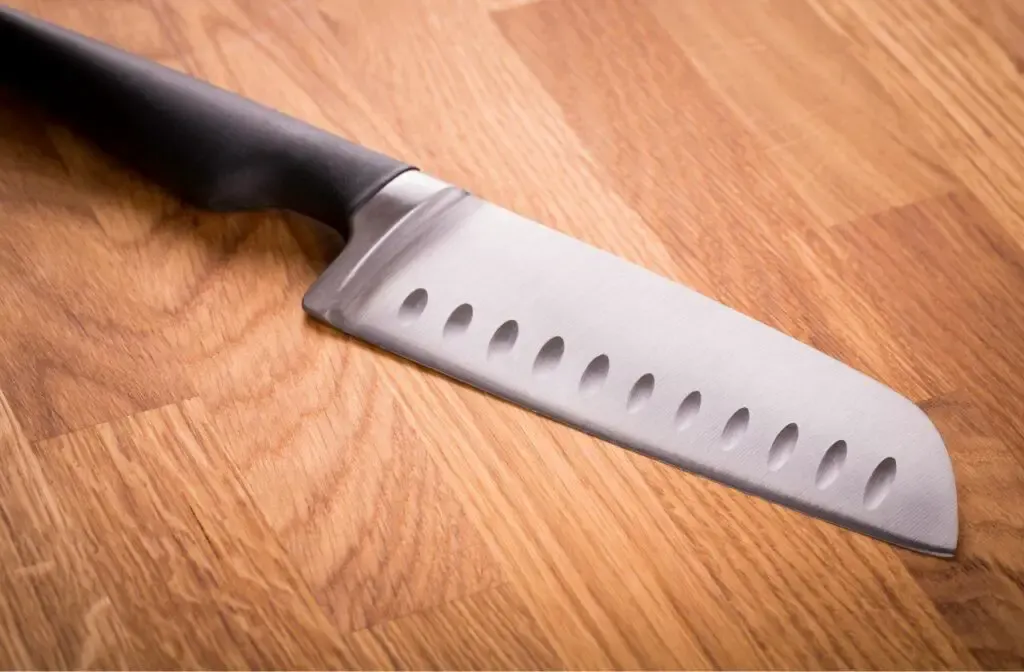
Santoku knives (Amazon link) are the baby brother of the Gyuto multipurpose kitchen knife. The Santoku is the most popular knife used in household kitchens in Japan instead of a Gyuto.
The name Santoku means “Three Virtues,” which relates to the ability to use this knife to process meat, fish, and vegetables.
The Santoku is a smaller, more compact knife than a Gyuto and does not have the same pointed tip. Much of the knife’s spine runs parallel to the cutting edge and quickly drops off to the tip in a sheep’s foot design.
This keeps a lot of mass in the knife throughout the length of the blade behind the cutting edge, giving additional robustness to the full cutting edge of the blade.
While the rounded tip of the Santoku makes it less likely to chip or break, it reduces the tip’s agility for fine-slicing work.
The handle is high enough to give the knuckles clearance for chopping vegetables, and the shorter blade offers more dexterity when wielding the knife. A Santoku knife typically has a blade of between 6.5 inches and 7 inches or 165mm to 180mm.
The shorter blade of the Santoku means that the cutting action may require two or three push-and-pull cutting strokes to cut completely through the meat.
A modern addition to some Santoku knives is a scalloped texture to the blade above the cutting edge. This design is also known as a Granton edge, and these scallops are particularly useful when slicing raw meat.
The hollowed-out scallops in the side of the blade break the surface tension between the flat of the blade and the raw meat. This prevents the meat from sticking to the side of the blade and helps it pass more easily through the meat.
If you are interested in buying a high-quality Santoku knife, we recommend checking out this knife made by the Yoshihiro company (Amazon link). The alternative (and cheaper) option is the Santoku knife made by Tojiro (Amazon link).
TIP: The santoku and the funayuki are two such Japanese design knives of similar size. Check out the main differences between these two Japanese knives in the article below:
Santoku vs. Funayuki: Six Main Differences You Should Know
Best Japanese Knives for Cutting Fish
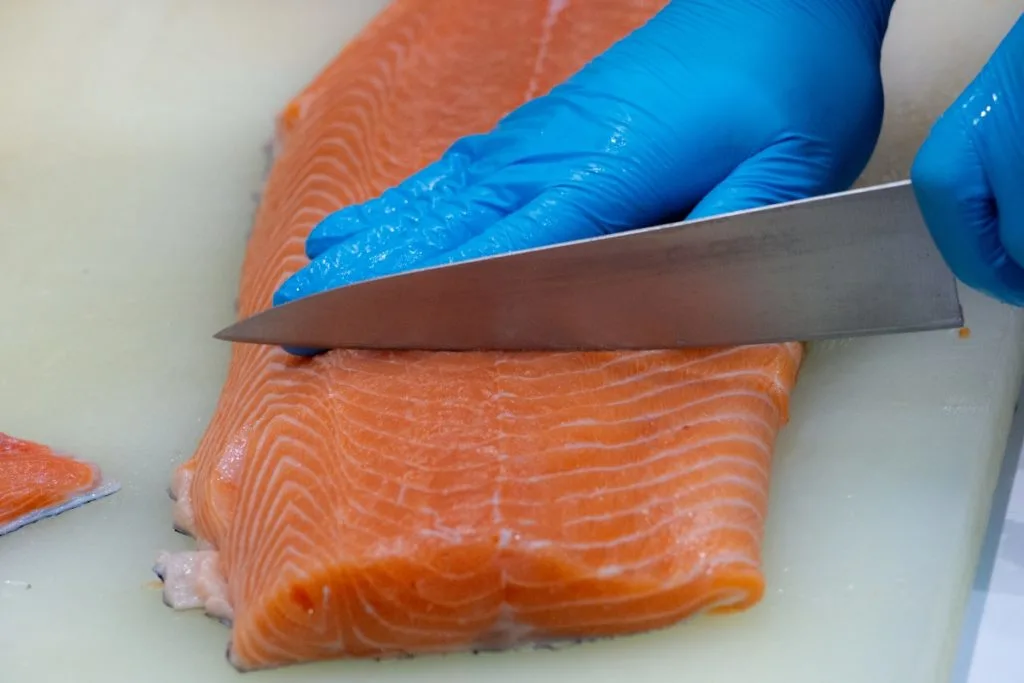
Japanese cuisine features fish of various forms and of various types. This focus on fish in Japanese food means that many Japanese kitchen knives are designed with processing fish in mind.
Due to the nature of processing fish for the kitchen, you generally require a few knives with different capabilities for each part of the process.
Filleting knives must have certain characteristics to efficiently and cleanly separate the fillet from the fish. In contrast, more robust knives are required for heavy-duty work such as removing the head.
If you have raw fish fillets that need to be sliced, there are many knives you can use to produce clean, precise slices of fish.
Any one of the following Japanese knives can be used to slice a fish fillet, even if fish processing is not their primary function (Amazon links):
- Gyuto. This multipurpose knife does a good job of slicing fish fillets if the fish has firm flesh, such as tuna or salmon.
- Santoku. Fish cutting is one of the “three virtues” the knife’s name alludes to, making it a good choice for slicing a fish fillet.
- Petty. A petty is a small utility knife, but the sharpness of these small-bladed knives is keen enough to slice smaller fillets or cut fish into pieces for a soup or stew. A Petty typically has a blade length of 4.7-inches to 7-inches or 120mm to 180mm.
- Yanagiba. This is a knife with a long blade, ranging from 10.6-inches to 13-inches or 270mm to 330mm. The long thin blade of this knife is designed specifically to cut thin slices of raw fish for sushi or a form of Japanese cuisine called sashimi, which features finely sliced raw fish.
- Fuguhiki. This knife has a similar design to the Yanagiba, but it is a little shorter. The Fugihiki is designed specifically to cut very thin slices of blowfish, known as Fugu in Japan.
BTW: If you want to know more about Japanese and other knives and their sharpening, check out the books listed above. These books are recommended by professional sharpeners and knife makers (Amazon links):
- Japanese Kitchen Knives: Essential Techniques and Recipes
- The Knifenerd Guide to Japanese Knives
- Knife: The Culture, Craft, and Cult of the Cook’s Knife
- Sharp: The Definitive Introduction to Knives, Sharpening, and Cutting Techniques, with Recipes from Great Chefs
Best Japanese Knife For Processing Fish
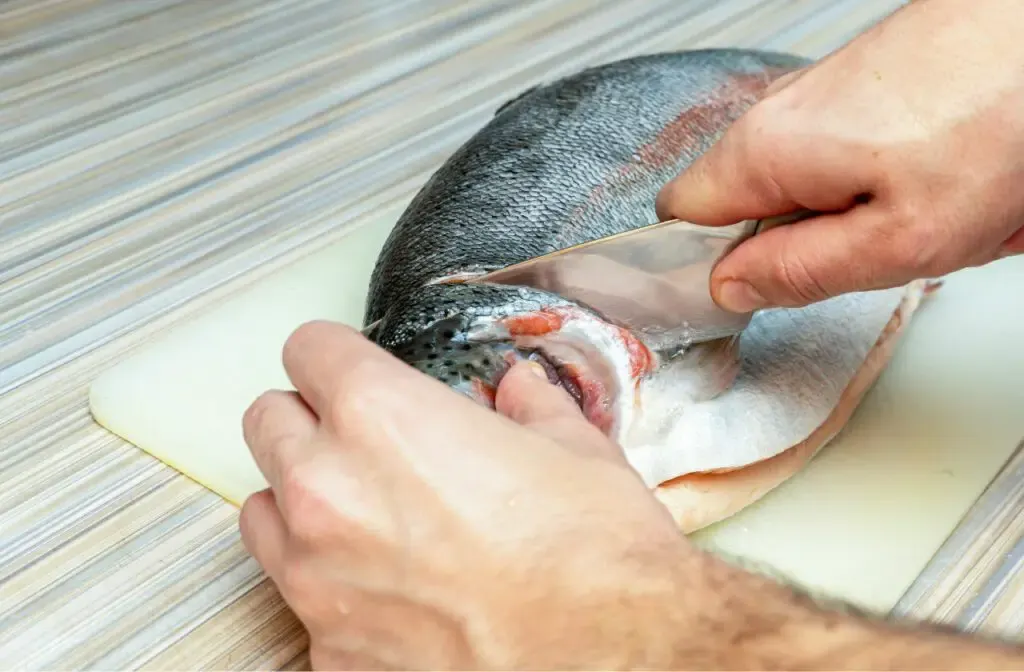
Processing a fish means more than filleting a fish. It includes the requirement of deboning the fish, removing the head, and cutting through other ribs and tough cartilage.
Knives dedicated to the filleting process generally do not have the thickness or mass in the blade to cut through fish bones without damaging the cutting edge.
Funayuki For Processing Fish
The Funayiki (Amazon link) is the traditional boating knife for Japanese fishermen. It is used onboard the fishing board for various functions, including the processing and cleaning of smaller fish.
The blade shape of the Funayuki is very similar to that of a Deba, but the steel is much thinner, making the knife lighter and more nimble. The thinner steel in the blade has a negative connotation in that the knife cannot cut through the thicker bones of larger fish.
Consequently, the Funayuki is reserved for small to medium-sized fish processing. The blade length of between 6.4-inches and 7.2-inches or 165mm and 185mm.
If you are interested in buying a high-quality Funayiki knife we recommend checking out this knife made by the Yoshihiro company (Amazon link).
TIP: Sushi chefs spend years perfecting their skills and understanding the art of sushi, but all this hard work can’t be done without some good tools. Check out the best Japanese knives for sushi in the article below:
Ultimate Breakdown: 4 Best Japanese Knives For Sushi
Deba For Processing Fish
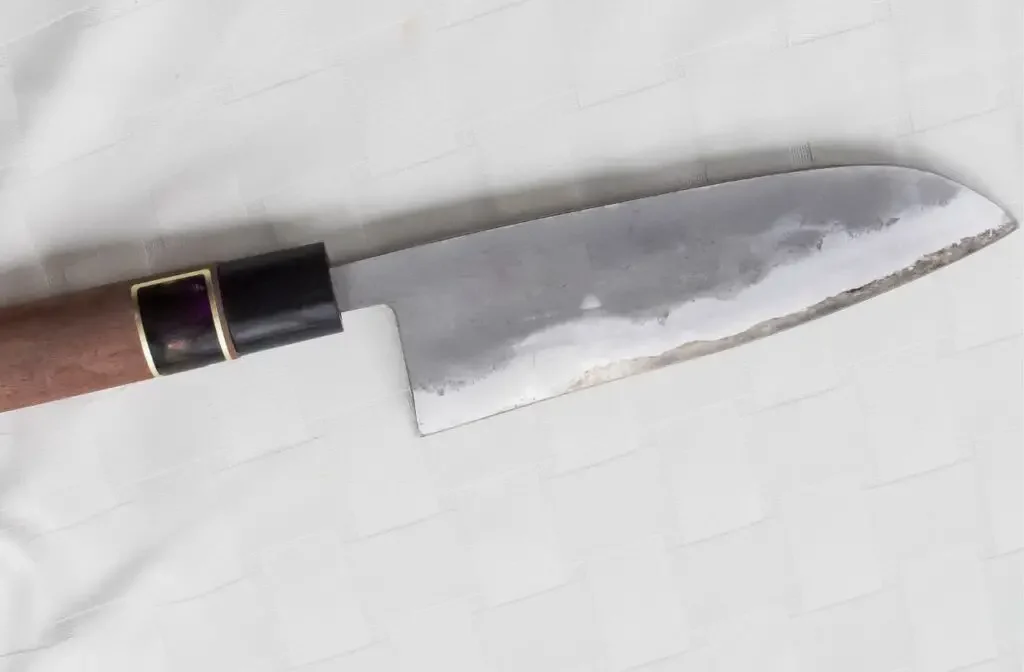
The Deba (Amazon link) is far and above the most versatile Japanese fish processing knife! The Deba comes in various sizes, from 4.7 inches to 8.2 inches or 120mm to 210mm blade lengths. The variety in length means that a kitchen may have a selection of Deba knives for processing fish of varying sizes.
Traditionally the Deba is a single bevel knife, but many manufacturers offer double bevel options. Western knife users generally prefer the double bevel version.
The Deba is a robust knife that is capable of processing the fish in its entirety, from filleting to cutting through rib bones, the spine behind the head, and cutting through the head.
The thickness of a Deba can vary from 5mm to 9mm, depending on the size of the knife. These thicknesses are unusual in other Japanese knives but give this knife the characteristics needed to be versatile in processing fish.
If you are interested in buying a high-quality Deba knife, we recommend checking out this knife made by the Yoshihiro company (Amazon link).
Best Japanese Knife For Filleting Fish
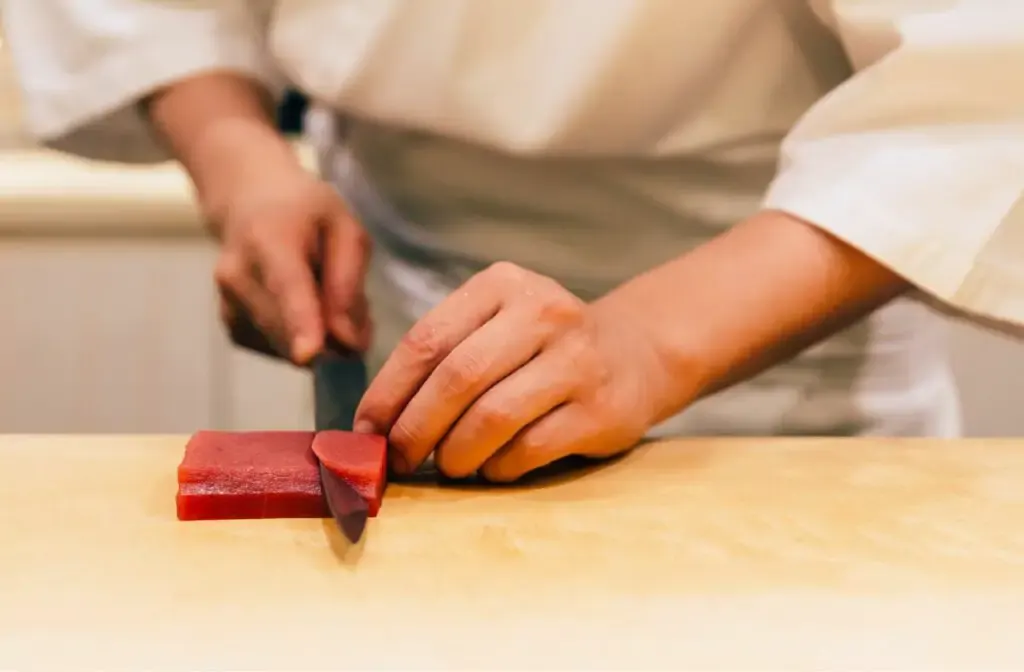
Filleting fish is the process of removing the fillet, or the main part of the fish, off the bone structure of the fish. This generally requires a very sharp knife, and in the Western world, a knife with a flexible blade.
The flexible blade is used to curve around the rib and bone structure of the fish to leave as little meat behind when filleting the fish. Japanese filleting techniques differ from Western methods, and a rigid knife with an extremely sharp edge is preferred.
True to form with the Japanese attention to detail, they even produce knives dedicated to filleting certain types of fish. The Magurokiri is a long blade knife made specifically for the task of filleting and processing large tuna.
Likewise, the Hamokiri is designed specifically to fillet the Pike Conger, a type of marine eel. Besides these two specialty fish filleting knives, Japan’s most popular filleting knife is the Deba.
The Deba is a versatile fish processing knife and the go-to Japanese kitchen knife for filleting fish. This knife is not as flexible as the Western filleting knives and requires a different technique for successfully removing the fillet from the fish.
TIP: The Funayuki and the Deba are two Japanese kitchen knives that look very similar at first glance. Check out the main differences between these two Japanese knives in the article below:
Funayuki Vs. Deba: The 5 Differences That Matter
Best Japanese Knife For Cutting Bones
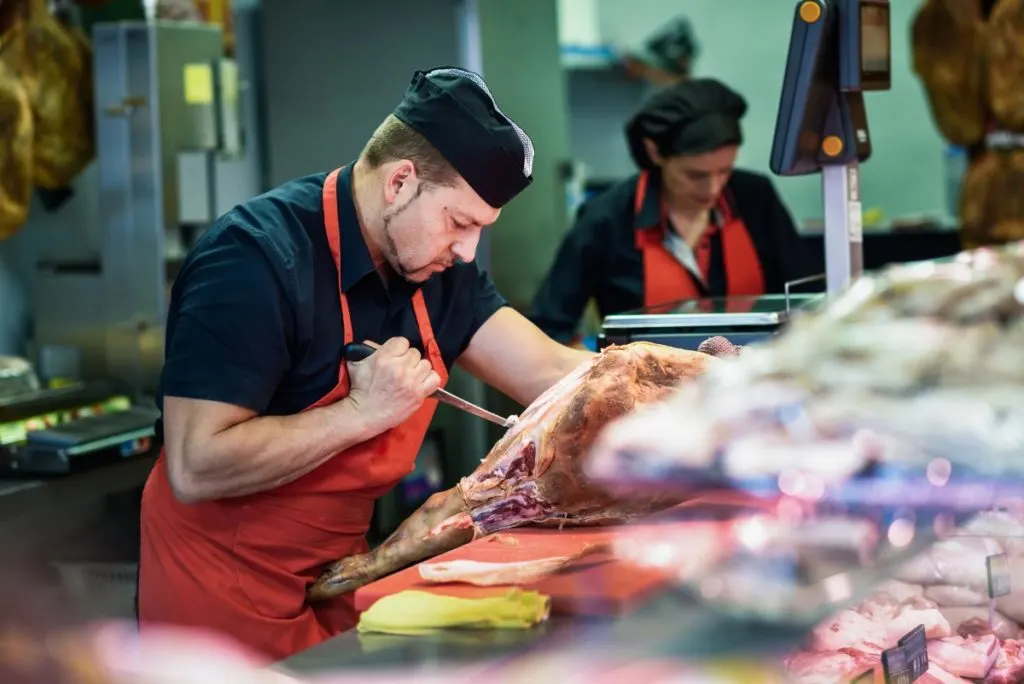
There is a difference between the process of boning meat and cutting through bone. No Japanese knives should be used to cut through bone. The hardness of the steel is not suitable for being pushed through bone.
The steel on the cutting edge can potentially chip or crack if it strikes a hard object like a bone in the meat. The bones found in beef are typically too dense and hard to be cut by any Japanese knife.
Poultry bones are less dense and are a little softer, meaning they will cause less damage to a knife than beef bone. However, most Japanese knives should not be used to cut through bone.
The one exception is the Garasuki, which is a thicker variation of the Honesuki, typically used to debone a chicken. The Honesuki is used to separate poultry carcasses into their component pieces by cutting through the ligaments to separate the joints, but it is not designed to cut through the chicken bones.
The Japanese boning knife intended for use on beef is the Hankotsu. The Hankotsu (Amazon link) is a fairly short-bladed knife, typically about 6 inches or 150mm long.
This knife is used to separate a hanging beef carcass. The blade is designed to penetrate joints to cut ligaments and muscles, but it is not made to cut through bone.
If you are interested in buying a high-quality Hankotsu knife we recommend checking out this knife made by the Misono company (Amazon link).
TIP: Honesuki and the hankotsu knives are both used for processing meat, so what are the differences between the honesuki and the hankotsu knives? Check out the article below:
Honesuki vs. Hankotsu: What’s The Difference?
Can Santoku Knife Cut Bones?
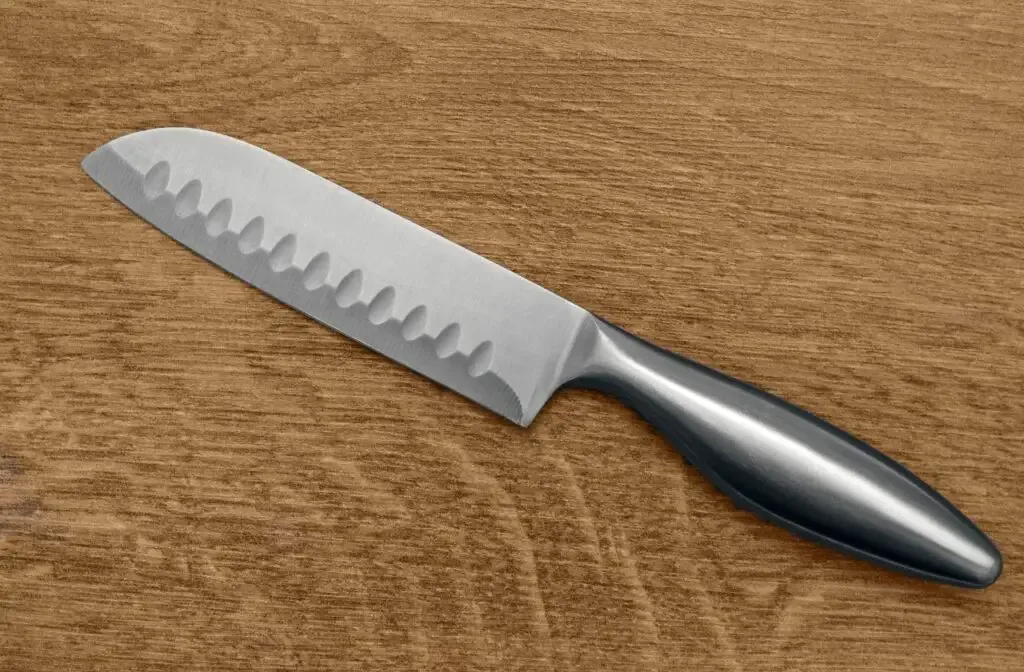
A Santoku knife is a smaller version of the Gyuto, and as such, it has a shorter and often thinner blade in proportion to its smaller size.
The thinner metal used in a Santoku knife makes the knife lightweight and can be ground to a very thin, sharp cutting edge. This blade geometry on the Santoku makes it unsuitable for cutting through bone, including poultry bone.
Cutting into the bone with your Santoku knife will, in all likelihood, severely damage the knife’s cutting edge and potentially ruin the knife to the point that it cannot be repaired.
Consequently, it is important to take special precautions to ensure that the Santoku blade’s edge never comes into contact with any bones while cutting meat.
TIP: Are you looking to buy a new whetstone? Check out our recommendations (we personally use the first three ones):
Our PRO choice whetstones combo (Amazon links):
- Fixing stone: Whetstone SHAPTON Ceramic KUROMAKU #320
- Sharpening stone: Suehiro CERAX soaking whetstone: Medium #1000
- Finishing stone: Whetstone SHAPTON Ceramic KUROMAKU #5000
Our budget choice (Amazon link): Sharp Pebble Extra Large Sharpening Stone Set
Comparing Japanese Knives
Japanese knives are renowned for their precision, craftsmanship, and specialization in various culinary tasks. Each type of Japanese knife is designed with a specific purpose in mind, making them indispensable tools in the kitchen.
The following table provides a comparison of six popular Japanese knives: Gyuto, Santoku, Honesuki, Sujihiki, Yanagiba, and Deba. It highlights their primary uses, strengths, weaknesses, and their effectiveness in cutting bone, meat, and fish.
| Knife Type | Primary Uses | Strengths | Weaknesses | Effectiveness For Bone | Effectiveness For Meat | Effectiveness For Fish |
|---|---|---|---|---|---|---|
| Gyuto | Multipurpose | Versatile long blade for clean cuts | Not suitable for bone | Not effective | Highly effective | medium effectiveness |
| Santoku | Meat, fish, vegetables | Compact, versatile, and good for household use | Shorter blade, less agile tip | Not effective | Highly effective | Highly effective |
| Honesuki | Poultry deboning | Perfect for poultry joints, sharp edge | Cannot cut through bone | Not effective | Highly effective | Medium effectiveness |
| Sujihiki | Slicing meat | Long blade for single-draw cuts | Not for bone | Not effective | Highly effective | Highly effective |
| Yanagiba | Sushi, sashimi | Designed for thin slices of raw fish | Not versatile for other tasks | Not Effective | Medium effectiveness | Highly effective |
| Deba | Fish processing | Robust and versatile for fish tasks | Not for large bones | Medium effectiveness | Highly effective | Highly effective |
It is essential to note that most Japanese knives, due to their sharpness and blade geometry, are not designed to cut through bone. Choosing the right knife for the task not only ensures efficiency but also prolongs the knife’s lifespan.
Conclusion
Most Japanese knives are adept at holding an extremely sharp edge, making many of the knives suitable for cutting raw meat. The problem comes when specialty cuts need to be made to remove meat from the bone or process proteins such as fish.
In these instances, it is best to use a Japanese kitchen knife specifically designed for the task of deboning the meat or filleting the fish!
For extremely thin and precise cuts for raw meat for sashimi and sushi, specially designed knives accomplish the task with ease and finesse, producing food well to look at as well as eat!
TIP: Japan has a long history in the production of steel and manufacturing of superior quality blades. Check out the complete list of Japanese knife steels in the article below:
Japanese Knives Steel Types (Complete List with Explanation)

